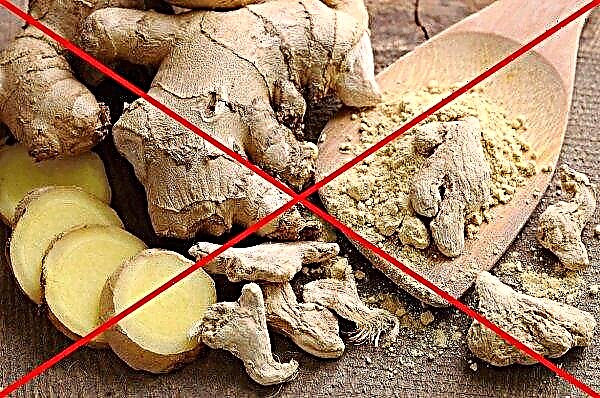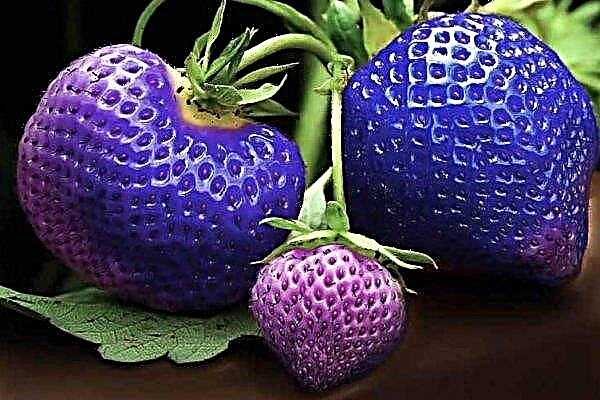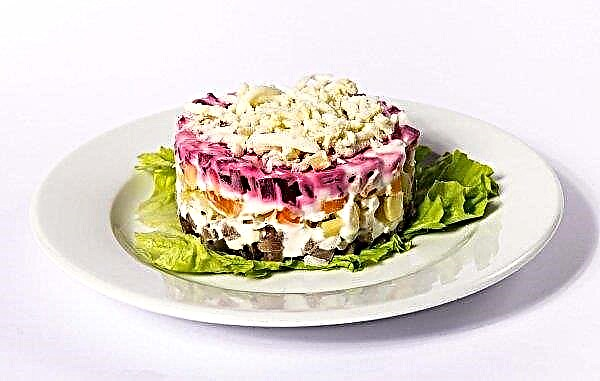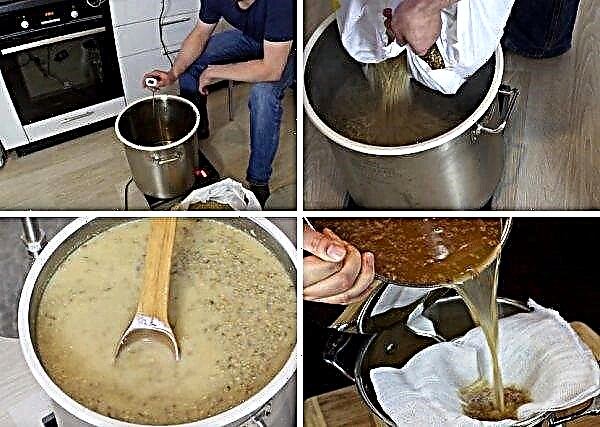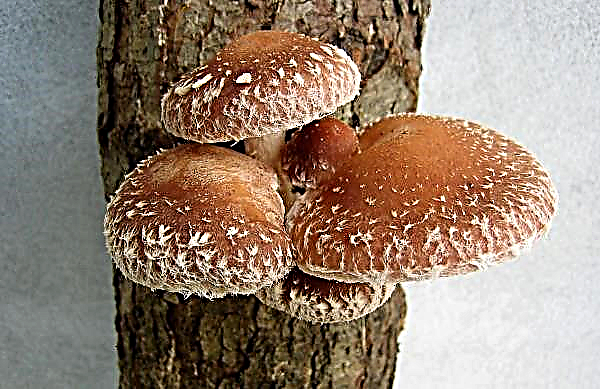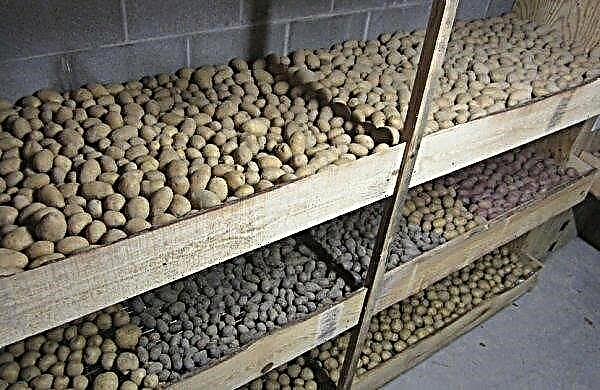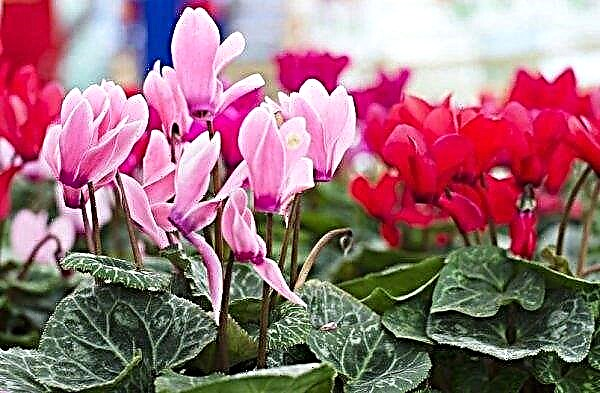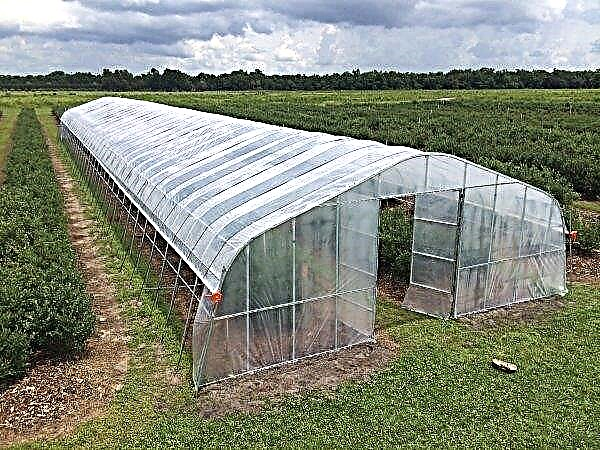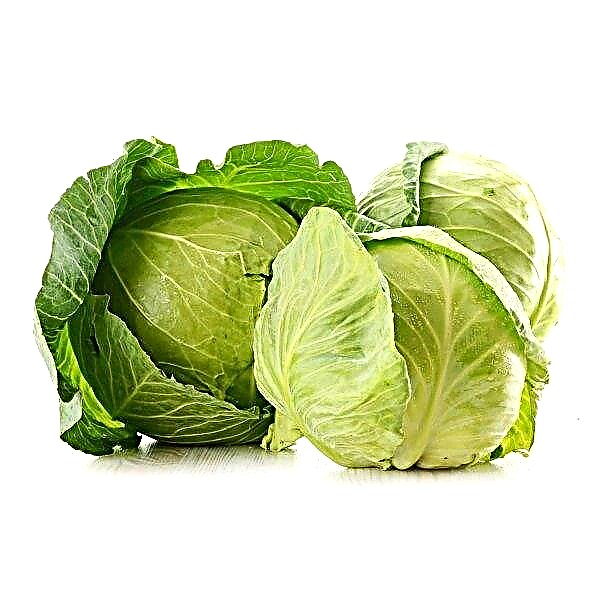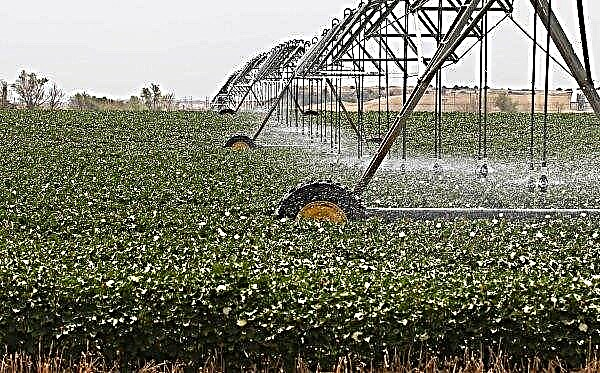Conifers are very popular among gardeners, including domestic ones. The variety of species and varieties makes it possible not only to decorate the infield, but also to make it environmentally cleaner. Particular attention is paid to junipers. About the bright representative of this species of conifers - the Golden Carpet variety, read further in the material.
Botanical Description
Juniper Juniperus horizontalis Golden Carpet - evergreen creeping shrub of the Cypress family. Its habitat is the highlands of the Northern Hemisphere. It is a variety with a superficial root system, slow-growing - annual growth of no more than 10 cm. The maximum size is 15–25 cm in height and 150 cm in width. The shape of the bush is horizontally spread. The shoots are long, spread along the ground. They are strong and resilient, tend to root.
The needles are small-scaly, with a characteristic golden yellow color on top and a greenish yellow bottom. It becomes bronze in autumn. Fruits are rounded cone berries, rarely formed. Their size is about 6 mm in diameter, the color is bluish with a white-blue hue. The plant is unpretentious in maintenance, easily adapts to various environmental conditions. Frost resistance is high, up to –35 ° С.
Landing
One of the most important stages in the cultivation of juniper on the site is its proper planting. Although Golden Carpet (translated from English - "golden carpet") is unpretentious, but still there are nuances on which the successful development of juniper depends.
Important! When planting in the shade, the needles will lose their special decorative appearance and turn green.
Seedling preparation
The first step is to purchase planting material. It is worth doing this in special nurseries in the territory of your region, as in such farms seedlings are grown in the appropriate climate, take root faster and tolerate transplantation less painfully. In addition, such a purchase guarantees the varietal affiliation of the purchased material, and nursery staff will be able to answer all questions of interest for planting and agrotechnics of creeping juniper. Before the acquisition, a thorough visual assessment of the seedling is worthwhile.
A quality copy is:
- the presence of growth in the current year;
- flexible and elastic shoots;
- uniform coloring of needles without visible damage;
- closed root system (container).

When buying, it is worth checking with the seller how the seedling was grown. The best option would be one that grew immediately in the container, and did not transplant from open ground or a greenhouse.
Important! All work with juniper must be carried out with gloves and protective clothing. Each part of the plant contains toxic substances: their contact with the mucous membranes must be washed with plenty of water.
Site selection and preparation
Another important factor is the placement of juniper on the site. For planting, a well-lit place is selected, light partial shade is acceptable. Planting is recommended in an elevated area, since the root system will deteriorate due to stagnation of moisture, and the plant may die. The soil should be slightly acidic, light sandy or loamy, well-drained and oxygen permeable.
The soil should be slightly acidic, light sandy or loamy, well-drained and oxygen permeable.
The place is prepared at least two weeks before disembarkation, but better for a few months. If, for example, planting is planned in the fall, then the site is ennobled in the spring. To begin with, you need to get rid of weeds and their roots, dig 30-40 cm in depth with the overturning of the earth layer. Coarse-grained sand is recommended for heavy clay soils, and peat and coniferous litter in equal proportions are added to alkaline soils.
Landing process
Seedlings with a closed root system can be planted at any time, but April - May or mid-October is more suitable.
Landing Stages:
- At the prepared site, landing pits are made for at least 3 bayonets of a shovel, 2-3 times wider than the size of an earthen coma and 1 m apart.
- Prepare a nutrient substrate - mix coniferous land (can be taken in the forest under the appropriate trees), peat and sand in equal parts. First, lay out a drainage layer 20 cm high - from pebbles, small stones, fragments of brick, slate, etc.
- A nutrient substrate is poured on it, abundantly watered with warm water.
- After absorbing moisture, the roots are gently released from the container and, together with an earthen lump, are transferred to the center of the pit.
- They straighten the roots and sprinkle with a fertile soil layer mixed with mineral complex fertilizer for conifers (Pokon, Bona Forte, Fertika) according to the instructions.
- After the roots are covered with soil so that the root neck is located at the level of the soil, tamped.
- Make a near-stem circle, watered with water.
- After absorption, a mulching layer (10-15 cm) of coniferous or wood sawdust, leaves, peat is applied.

When planting, it is worth considering the peculiarity of the shoots to take root, so it is recommended to place up to 3 copies per 1 m² for the groundcover effect.
Juniper Care
To Golden Carpet pleased with its decorative appearance, it is necessary to care for it accordingly. As a rule, agricultural technology is simple - watering, fertilizing, cutting. About all stages in more detail below.
Did you know? Juniper life spans can reach 500 years.
Watering
After planting, young growth is regularly moistened during the first 7-10 days. Then they maintain soil moisture, avoiding stagnation of water at the roots. Adult specimens do not need frequent watering. In the summer, 3-4 irrigation is enough. The described variety does not tolerate dry air, so the branches of young plants need to be sprayed from a spray bottle, and adults should be sprinkled from a watering can with room temperature water. This is done in the early morning or after sunset.
Top dressing
This juniper does not need much fertilizer. Enough for each bush (in the near-stem circle) once in April - May or in August - September, add 30–40 g of nitroammophoski, and then carefully water the planting.
Did you know? In the dishes from juniper products long time do not spoil even in hot weather.
Loosening and mulching
Loosen the soil in the near-stem circle on a regular basis, since the roots need oxygen access. Given the peculiarity of the root system - it is quite fragile, it must be done carefully, to a depth of not more than 10 cm, and special attention should be paid when loosening the soil under young shrubs.
Mulching will help to avoid such frequent procedures and protect the root system from drying out. Sawdust, coniferous bark or wood chips, peat, leaves, etc. are suitable for the mulching layer. Its thickness should be at least 5 cm.
Pruning
For landscape design, the decorative appearance of the bush is important. To do this, carry out a shaping haircut in mid-July, using fairly sharp garden shears or pruners. Such a procedure is not often resorted to, because the variety is slow-growing.Golden Carpet also needs sanitary scraps. To do this, in the early spring, before the start of the growing season (sap flow), dry, damaged by frost or broken by snow cover rotted branches are removed. Thus, all shoots that do not match the healthy appearance of the plant are cut.

Winter preparations
Before wintering, it is worthwhile to conduct a visual assessment of the shrubs and remove damaged branches. Then you need to remove the old mulching layer, loosen and water the trunk circle well, after absorbing moisture, apply a new mulch at least 12 cm thick. Peat or spruce branches are ideal for her.The frost resistance of the variety is excellent, so it does not require additional shelter.
Possible diseases and pests
Occasionally, the horizontal juniper Golden Carpet can be damaged by diseases and pests.
This happens for several reasons:
- frequent watering;
- thickening of the landing;
- sick planting material;
- adverse weather conditions, etc.
Important! All working solutions must be diluted in accordance with the instructions for a specific drug. Work must be carried out in protective clothing, gloves and a mask.
Disease
- Rust - manifests itself with the advent of spring. Brown-yellow bulges of a rounded jelly consistency form on juniper shoots. During the development of the disease, the branches become thicker, change shape, cracks appear on them. In early September, the formations become darker; a wintering form of the fungus forms in them. If rust symptoms are detected, it is worth immediately removing and burning the damaged needles and branches, and treat the shrubbery, tree trunk and neighboring plants with fungicides (Fundazol, Topaz, Folikur, etc.). For prevention, spraying with Bordeaux liquid (1% solution) or vitriol (copper, iron) is carried out at the beginning and end of the season. In autumn, weeds and other plant debris (branches, leaves, needles) are removed from the site.

- Fusarium - Another type of fungal disease of juniper. The lesion occurs through the damaged bark, spreading and clogging the vascular system, while the roots of the bush die off. Without nutrients, the needles on the upper shoots first turn yellow, then red and gradually fall off. Over time, the landing completely dies. Most often, young and weak specimens suffer. The factors provoking the disease are heavy clay soil, stagnation of moisture at the roots, high groundwater passage. At an early stage of the disease, plants are treated with fungicides - Bordeaux liquid (1% solution), "Alirin B", "Fundazol", "Fitosporin-reanimator", copper chloroxide, copper sulfate. With a massive lesion, diseased bushes are removed with roots and disposed of off-site. For prophylaxis, twice a year (in spring and autumn), planting is treated with copper sulfate or 1% solution of Bordeaux fluid.

- Drying out branches - also fungal infection. Infection occurs, as in the previous case, through damage to the bark: it dies, and the needles dry and crumble. On the affected branch, at the site of invasion, the formation of fruiting bodies of black color is visible. Most often, thickened plantings are affected. For treatment, diseased shoots are initially cut to healthy tissue. Sections are treated with copper sulfate, Bordeaux mixture (1% solution) or with Abiga-Peak and HOM preparations. For prevention, all mechanical damage is lubricated with garden varnish and spraying is carried out - as in the previous case.

- Branch bark necrosis Is a cancerous disease. Plants are infected through damaged bark. Fruit bodies of red-brick color at the initial stage and black in the process of development are formed at the site of invasion. The diseased branch turns yellow, dries and disappears. Control and prophylaxis measures are the same as for drying branches.
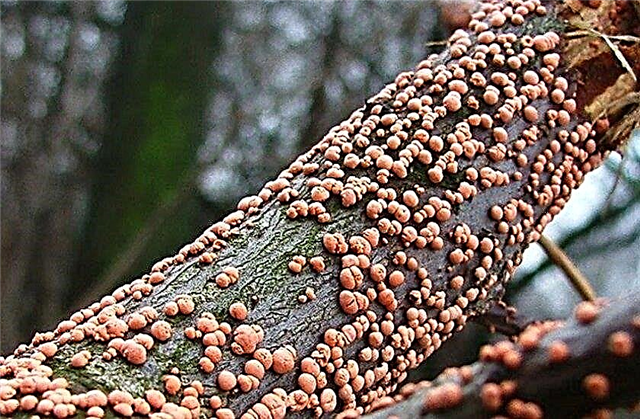
Pests:
- Juniper aphid - small (about 2-3 mm) brown insects with a slight dusting. They appear at the beginning of the growing season and until September they suck the juice from the needles on the shoots, branches and in the cracks of the trunk. To fight, damaged bushes are sprayed with Calypso, Confidor and other insecticides.

- Mealybug - females about 3 mm long, oval, brown in color, with a powdery wax coating of a white hue, males with wings. They hibernate in the form of larvae in the damaged bark. With the advent of spring, they move to young shoots, prefer to settle in the coniferous sinuses, below the crown. With severe damage, the needles change color and crumble. It is difficult to exterminate insects: it is necessary to treat plants with systemic pesticides 3 times or more, with a frequency of 10 days. In this case, drugs should be changed, choosing with a different composition and active substance. "Angio" received good recommendations from gardeners in the fight against mealybug.
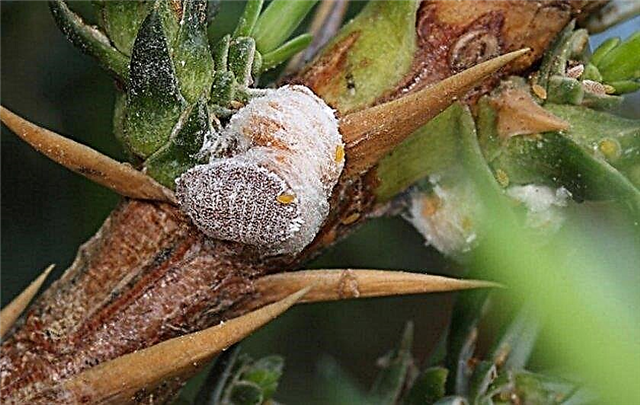
- Juniper moth - the parasite settles in the thick of branches. Butterflies with bronze-brown wings, the span of which is about 10 mm. The caterpillars are brown, 3 strips of brick-red color protrude on the body, the head is shiny. Young and adult specimens eat at different periods, and this happens from April to autumn. In the spring they do the greatest harm. The branches are intertwined in large nests. Young live in the needles of a new growth. With a massive lesion, about 80% of the needles are damaged. To destroy the pest, it is necessary at least 2 times with an interval of 10 days to process damaged shrubs with systemic drugs ("Enzhio", "Confidor", etc.).
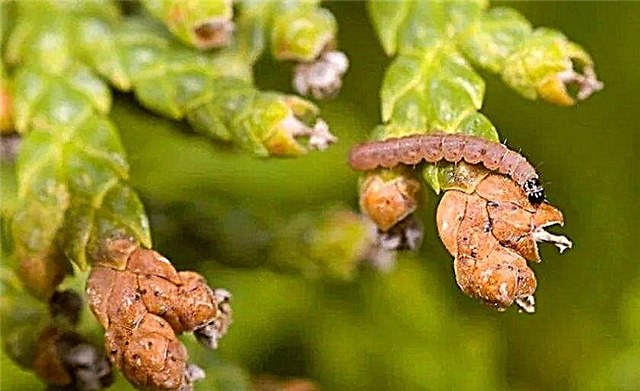
- Tick Oregon Flat - visible only under a microscope. Settles in the bark and dry needles. With the defeat, the needles lose their usual color, which is often attributed to fungal diseases. To fight at least 3 times with an interval of 10 days, acaricides are sprayed - Caesar, Nurel-D, etc.
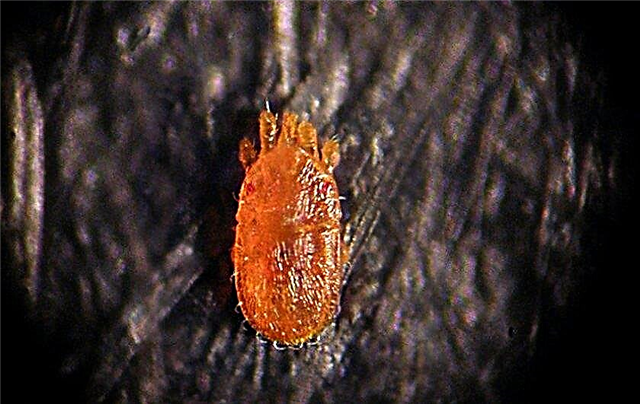
Breeding methods
The variety in question is propagated in three ways:
- by seeds;
- cuttings;
- rooting layering.
Did you know? As the dream books say, if you dreamed about juniper, expect life changes - wealth and good fortune in all your endeavors.
The first method is suitable for mass production of seedlings, but does not guarantee the preservation of varietal characteristics.
For its application it is necessary:
- Collect blue cones in the fall. If they are not opened, they should be laid out in a warm place and then the seed material must be collected.
- Next, the seed is placed in wet sand or perlite for about 2-3 weeks.
- Planting in containers is carried out to a depth of 2 cm, it is better to buy soil in the store specifically for conifers.
- In spring, pots with sprouts can be taken outside, leaving them under the trees.
- As seedlings grow, it is transplanted into larger containers.
- At a permanent place of disembarkation is made no earlier than three years of age.

For propagation by cuttings:
- The material is harvested in wet weather at the end of summer (August). At the same time, the top of the shoots is cut by a third.
- The blanks are cleaned of needles and placed in water with a rooting agent, for example, Kornevin, for 5-6 hours.
- Then prepare the planting substrate of sand, peat and coniferous land (proportion 2: 1: 2).
- At the bottom of the container, lay a 5–7 cm thick drainage layer of pebbles, brick fragments, etc., fill it with a nutrient mixture.
- Landing is carried out at an inclination of 30 °.
- Next, the seedlings are placed in a greenhouse with an optimum temperature of + 15 ° ... + 17 ° C. After budding, the temperature rises to + 25 ° C, while the humidity should be at least 70% (air and soil).
- It is possible to transplant in the open ground for the next season.

The layering method is suitable for those who already have creeping juniper growing on the plot.
- In the spring, loosen the soil under the future layering, make furrows to the size of the shoot, pour peat and sand in equal parts in them, pour it. The optimal for this method will be a healthy strong branch with an age of more than three years.
- Over the entire length of the shoot, it is necessary to make incisions with a sharp knife at a distance of 10-12 cm - from them roots will appear in the process.
- The branch is carefully laid in a trench, sprinkled with fine-grained sand, fixed with metal staples and watered.
- During the summer period, the soil is kept moist, sand is added as necessary.
- Separate rooted shoots can be next spring.

Use in landscape design
Often Golden Carpet planted near ponds. At the same time, the latter is covered with two rows of decorative stones, and juniper is planted between them. You can dilute the planting with bright colors to add color. You can smash a flower bed.To do this, a coniferous tree, a bright shrub, for example, spirea or jasmine, are planted as a tapeworm, and juniper is planted around in a random order. To border the edges of the flower beds use stones.
It can also be grown in containers for landscaping loggias, balconies, terraces.Creeping varieties are an excellent groundcover material that will strengthen the slope and rid the area of weeds. In general, the range of application of juniper can be limited only by the imagination of the gardener.
Choosing Golden Carpet for decorating the site, you will end up with a beautiful creeping shrub, unpretentious in maintenance. At the same time, the landing will not only please the eye, but also cleanse the air around. It is important to adhere to simple agricultural techniques, so that the plant adorns your garden for a long time.









